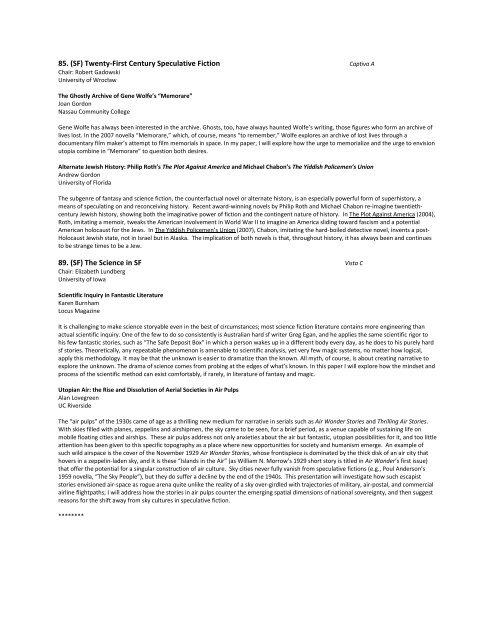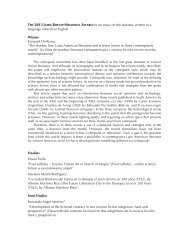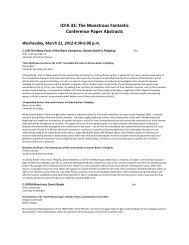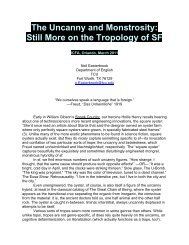The Monstrous Fantastic Conference Paper Abstracts - International ...
The Monstrous Fantastic Conference Paper Abstracts - International ...
The Monstrous Fantastic Conference Paper Abstracts - International ...
You also want an ePaper? Increase the reach of your titles
YUMPU automatically turns print PDFs into web optimized ePapers that Google loves.
85. (SF) Twenty-First Century Speculative Fiction Captiva AChair: Robert GadowskiUniversity of Wrocław<strong>The</strong> Ghostly Archive of Gene Wolfe’s “Memorare”Joan GordonNassau Community CollegeGene Wolfe has always been interested in the archive. Ghosts, too, have always haunted Wolfe’s writing, those figures who form an archive oflives lost. In the 2007 novella “Memorare,” which, of course, means “to remember,” Wolfe explores an archive of lost lives through adocumentary film maker’s attempt to film memorials in space. In my paper, I will explore how the urge to memorialize and the urge to envisionutopia combine in “Memorare” to question both desires.Alternate Jewish History: Philip Roth’s <strong>The</strong> Plot Against America and Michael Chabon’s <strong>The</strong> Yiddish Policemen’s UnionAndrew GordonUniversity of Florida<strong>The</strong> subgenre of fantasy and science fiction, the counterfactual novel or alternate history, is an especially powerful form of superhistory, ameans of speculating on and reconceiving history. Recent award-winning novels by Philip Roth and Michael Chabon re-imagine twentiethcenturyJewish history, showing both the imaginative power of fiction and the contingent nature of history. In <strong>The</strong> Plot Against America (2004),Roth, imitating a memoir, tweaks the American involvement in World War II to imagine an America sliding toward fascism and a potentialAmerican holocaust for the Jews. In <strong>The</strong> Yiddish Policemen’s Union (2007), Chabon, imitating the hard-boiled detective novel, invents a post-Holocaust Jewish state, not in Israel but in Alaska. <strong>The</strong> implication of both novels is that, throughout history, it has always been and continuesto be strange times to be a Jew.89. (SF) <strong>The</strong> Science in SF Vista CChair: Elizabeth LundbergUniversity of IowaScientific Inquiry in <strong>Fantastic</strong> LiteratureKaren BurnhamLocus MagazineIt is challenging to make science storyable even in the best of circumstances; most science fiction literature contains more engineering thanactual scientific inquiry. One of the few to do so consistently is Australian hard sf writer Greg Egan, and he applies the same scientific rigor tohis few fantastic stories, such as “<strong>The</strong> Safe Deposit Box” in which a person wakes up in a different body every day, as he does to his purely hardsf stories. <strong>The</strong>oretically, any repeatable phenomenon is amenable to scientific analysis, yet very few magic systems, no matter how logical,apply this methodology. It may be that the unknown is easier to dramatize than the known. All myth, of course, is about creating narrative toexplore the unknown. <strong>The</strong> drama of science comes from probing at the edges of what’s known. In this paper I will explore how the mindset andprocess of the scientific method can exist comfortably, if rarely, in literature of fantasy and magic.Utopian Air: the Rise and Dissolution of Aerial Societies in Air PulpsAlan LovegreenUC Riverside<strong>The</strong> “air pulps” of the 1930s came of age as a thrilling new medium for narrative in serials such as Air Wonder Stories and Thrilling Air Stories.With skies filled with planes, zeppelins and airshipmen, the sky came to be seen, for a brief period, as a venue capable of sustaining life onmobile floating cities and airships. <strong>The</strong>se air pulps address not only anxieties about the air but fantastic, utopian possibilities for it, and too littleattention has been given to this specific topography as a place where new opportunities for society and humanism emerge. An example ofsuch wild airspace is the cover of the November 1929 Air Wonder Stories, whose frontispiece is dominated by the thick disk of an air city thathovers in a zeppelin-laden sky, and it is these “Islands in the Air” (as William N. Morrow’s 1929 short story is titled in Air Wonder’s first issue)that offer the potential for a singular construction of air culture. Sky cities never fully vanish from speculative fictions (e.g., Poul Anderson’s1959 novella, “<strong>The</strong> Sky People”), but they do suffer a decline by the end of the 1940s. This presentation will investigate how such escapiststories envisioned air-space as rogue arena quite unlike the reality of a sky over-girdled with trajectories of military, air-postal, and commercialairline flightpaths; I will address how the stories in air pulps counter the emerging spatial dimensions of national sovereignty, and then suggestreasons for the shift away from sky cultures in speculative fiction.********





